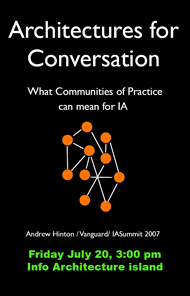I haven’t written here in many weeks, but it’s not because I’m not writing.
Lately, though, my thoughts have been too fractured to coalesce into anything that felt like a real blog post. I’m now realizing, however, that they never will unless I unclog the cognitive drain, as it were.
So, this post, in a sense, will be like a visit from Roto-Rooter ™.
– IA tends to be about how users experience information space through time; one space linking to the next, as opposed to how things are arranged and behave on a page or screen. Only way to do this is semantically (language); physical architecture can actually shape space with objects. IA is about the Z axis. I am here, and *THEN* I am here. Links are about time — they shape it, chop it into discrete experiences, even name it.
– Eno’s idea that all culture is a simulacrum, that it’s all invented bits of identity that we can play in, try out. Shopping, movies, fashion, art, music — all of it. (Also love his idea that “culture is everything you don’t have to do.”
– IA provides simulated places, directions to try. Playfulness encompasses this too — moving into, through, past various options — aggregating into something we retroactively experience as a narrative arc. (But that’s constructed by the user … any arc we try to create artificially just gets in the way of this act of meaning-making by the user. We don’t make meaning, we provide spaces for users to do that).
– Will Wright’s phrase: “Possibility Spaces” — great phrase for thinking about IA.
– Whole buildings have been redesigned to change the way people move through them, to get different effects — more conversations, more efficiency, whatever. Virtual spaces have similar effects. What makes MySpace, LinkedIn and Facebook different are just a few basic design choices, mainly around rules & permissions. It’s not their tab-structure that makes them different, it’s the rules — what I’m seeing as the truly architectural aspect of virtual space structures.
– Categories = walls; choosing one semantic structure over another, by default removes all others from play. You can add more, but you can’t add infinitely, or it becomes structureless. Every choice is to promote one thing over all other things (or all other things not also promoted). Just as putting a wall in a building means you can’t walk that way anymore. So categories function just like rules and permissions.
– Rules & permissions, then, are perhaps the bigger entity — and categories are a species of them? Thinking about that… but, at any rate, they’re definitely architectural in nature, and yet we don’t discuss them that much in IA circles. Others are all over it — Clay Shirky, game designers like Will Wright, Craig Newmark, Jimmy Wales, Zuckerberg, others…
– I think it’s IA even if they don’t call it that.
– RS Wurman coined the term IA but it was about representations — maps — that helped us cognitively grok some external reality.
– Then the Web happened, and the map became the landscape — so now IA is about a thing that describes itself (it has to, because on the web, any attempt to effectively map the digital space becomes part of the digital space itself). It’s like one of his ACCESS guides, but one that you literally enter and walk around in — the city and the guide are the same.
– Maybe I love IA for the same reason I loved creating ‘dungeons’ as a kid playing D&D, and later making interactive structures in MUDs and MOOs? Making ‘possibility spaces’ and seeing what design tweaks result in what kinds of experiences?
– Shirky says “there’s no such thing as IA” because, to him, there can be no single authoritative structure anymore — but then points to examples of rules and labels in things like Delicious that, at least in my view, are definitely IA — they’re just not ‘categorization & organization’ IA — they’re the logic of the space that allows people to make sense of and use Delicious. Plus, even if there is no actual IA, it doesn’t mean we don’t experience or perceive it as such. Zen Buddhists say there is no actual “self” but they still name their kids.
– The idea that we organize around objects — network around them — is very powerful. We don’t even see them much of the time, because they’re so taken for granted — we think the relationship exists in and of itself, but it doesn’t. Or rather, it needs a medium to take hold, to instantiate itself — but the relationship likely wouldn’t have begun without that object to begin with. There’s no there there, without the object. (Teaches us something about IA, no? There’s no link without things to link … but those things don’t exist to one another without the link…)
– Conversations are the basis of all of this work, and have always been. Library Science is founded on centuries of Slow Conversations — so slow because they take place in books, over time, using physical spaces and media. One book or article answers another. It was the only way for people divided by space (and time) to have these conversations — later broadcasting, but that too took a lot of time and material for production. Think of it as a very slow chemical reaction — something that takes many years, like fine wines or something?
– The internet has essentially sped up that chemical reaction, put a burner under the test-tube, and made it so that the previous containers & processes are breaking down somewhat. Conversing, organizing, collaborating — all can take place with almost zero inertia. A sort of Cambrian Explosion.
Ok… that’ll do for now. There’s more in my notes, but this is getting to be crazy long.




